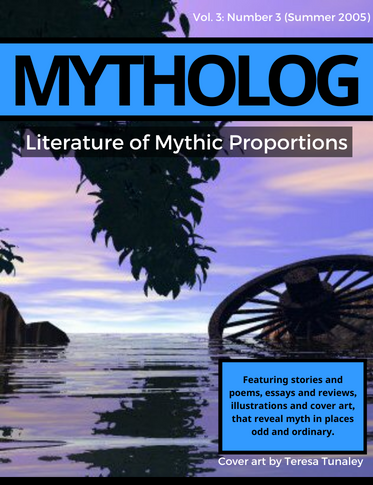
Volume 3 Number 3
Summer 2005
Teresa Tunaley's "Wheel Cover" blends past and present with a subtle theme of fluidity. You can find more of her covers in our past issues, and a link to her site can be found by following the "About Us" link to our Links.
Summer Issue
Boundaries. That's the theme that seems to be running through this issue of MYTHOLOG. The boundary between mortals and the other worlds in a myth of gods and mermaids. Between desire and despair in a fairy tale ending. Vanity and purpose with the wandering Jew. Dreams and waking life in a dish of eggs. Freedom and fate in a room full of bishops. Hope and faith in the heroism of the small. Absurdity and art in a biological conundrum. Death and immortality with the immortal sidhe. Even history and time in the motion of our seasonal cover. So cross over with us. Turn left at the dead end, and step across the threshhold into a full issue of wonderful tales and poems that we hope will make you want to stay just this side of ordinary experience. -- Asher Black, Editor-in-Chief
Fiction
Mermaid of the Great Sea
by Norman A. Rubin
If the sounds of wave and wind have ever seemed like the song of lovers, perhaps they are.
Chasing the Wind
by Robert Rhodes
Stop at a local diner, have a cup of coffee, and think about where you are and what you are doing. Is there anything better than this?
Gormlo the Green
by Christie Maurer
It's possible to want something so badly that you're willing to wait forever, even if it will never come.
Man Who Mistook his Stomach
by William I. Lengeman III
Kafka's work frequently commented on the absurdity of the banal. What about the absurdity of the extraordinary?
Poetry
Fairy Tale Ending
by Marsheila Rockwell
What is a happy ending? Is it happy for everyone?
Some things about eggs
by Mary Pat Mann
How often do you have dreams and are unsure of what they really mean?
Seventh Mosaic Soliloquy
by Joseph P. Farrell
If God knows everything in advance, then can man be truly free? Perhaps it is the question that is flawed.
Banshee
by Jacqueline West
Have you ever heard a sound on the wind that you knew was neither wholly of this world nor safely distant from it?
First liquid color scheme. Time and motion. The boundary between mortals and the other worlds in a myth of gods and mermaids. Between desire and despair in a fairy tale ending. Vanity and purpose with the wandering Jew. Dreams and waking life in a dish of eggs. Freedom and fate in a room full of bishops. Hope and faith in the heroism of the small. Absurdity and art in a biological conundrum. Death and immortality with the immortal sidhe. 8 works.